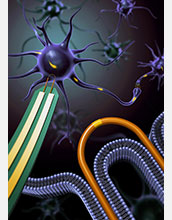
Research News
New technique allows faster creation of nanowire devices to find what’s happening inside our cells
July 12, 2019
In August 2010, Charles M. Lieber, the Joshua and Beth Friedman University Professor at Harvard University, published a paper on nanoscale devices for intracellular recording, the first nanotechnology developed to record electrical chatter inside a live cell. Now, in a paper published in Nature Nanotechnology, Lieber and his team present an update to his original research. The team has designed a way to make thousands of these devices at once, creating a nanoscale army that could speed efforts to find out what’s happening inside our cells.
Silicon nanowires are far longer than they are wide, making them wobbly and hard to wrangle, like cooked spaghetti. Lieber created nanowires in his earlier work and, using this method, the team built an environment where the wires could germinate on their own. Each wire’s diameter and length can be predetermined but their position can’t be controlled, so the result is a tangled mess.
To fix the problem, Lieber and his team designed a trap for their loose “cooked noodles,” making U-shaped trenches on a silicon wafer and then “combing” the nanowires across the surface. This combing process untangles the mess and deposits each nanowire into a neat U-shaped hole.
With the combing method, Lieber and his team complete hundreds of nanowire devices in the same amount of time they used to make just a few. “Because they’re very well-aligned, they’re very easy to control,” says Anqi Zhang, a member of the Lieber Lab and a co-author on the team’s latest work.
Siheng Sean You, a co-author on the study, was supported by an NSF Graduate Research Fellowship.
—
NSF Public Affairs,
(703) 292-8070 media@nsf.gov
Source: NSF News
Brought to you by China News








